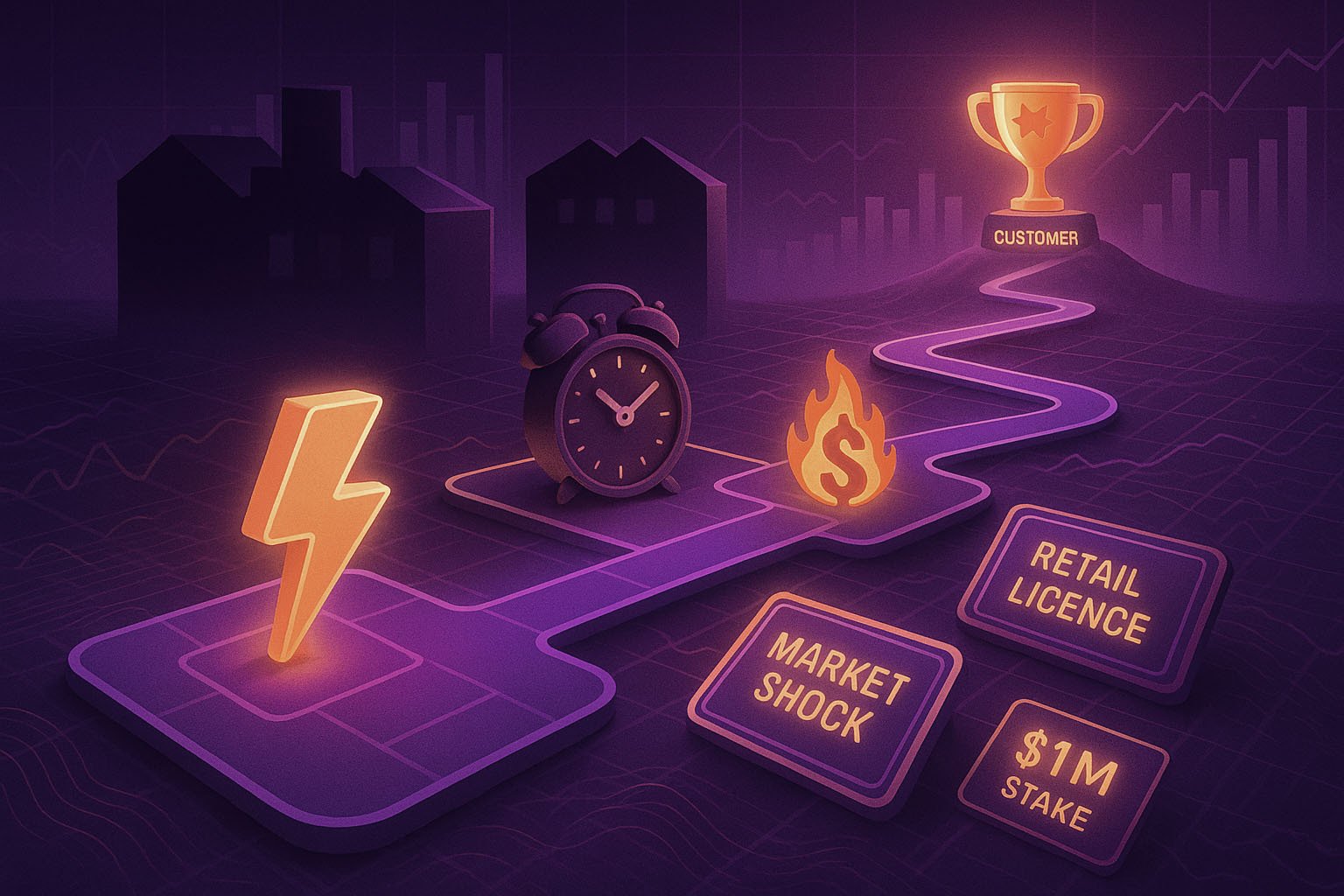What’s the deal with retail?
Does our creativity know no bounds?
Welcome to Electricity Retailing, the cutthroat game to see who can run the gauntlet and come out on top! Think you’ve got what it takes? You’re not alone, but there have been many past players who’ve tried and failed.
The lure of playing Electricity Retailing is strong. Particularly for those who have never played before, the potential pay-off seems to outweigh the complexity. Maybe you sell technology and if you could just get access to those juicy wholesale market price signals you’d dominate the market and lock in your customers FOREVER. Maybe you’re already successfully selling internet plans or petrol or pool pumps - you’ve already got the customers and bundling in electricity contracts looks like free money. When you look out across the market, all you can see are pesky, cumbersome retailers who are hoarding all that value for themselves.
To survive and thrive, you’ll need to work your way through the various levels: regulatory pitfalls, market risks, the large incumbents who’ll look to crush you and of course, the churning energy transition. Even if you make it through all that, you may end up wiped out by a badly timed Chance card!
What strategies will you take? How many customers can you win? Let’s play Electricity Retailing.
Setting up the game
This is one of those games with internet forums and YouTube explainers dedicated to the rules. We’ll go through the background, how you win, and the various levels you’ll need to get through!
You’ll need to start by deregulating your electricity market. You can’t play Electricity Retailing in every country. In some electricity markets, you’ll need to settle for a tedious game of fully centralised ownership of all components of the supply chain. If you’re playing anywhere in Australia aside from WA, there has been competition in electricity retailing since the early 2000s. God knows what those Westerners are up to.
Allowing competition has meant multiple different retailers now fight for the business of electricity consumers every day.
Easter eggs abound
The aim of the game is to set up and scale a thriving electricity retail business. But what does that actually mean? Electricity retailers are responsible for the electricity used by consumers. However, they don’t have any physical control over the flow of electrons. Rather, they are an intermediary that buys power from the wholesale market and resells it to their customers with some margin added.
Source - SAPN
When you boil it down, there are two things that are the core business of electricity retailers:
Billing for electricity. All the electricity flowing through the National Electricity Market has to be paid for. When a business consumes power, it is registered on their electricity meter. The retailer is responsible for paying the market for this electricity and invoicing the customer. In addition, the retailer needs to bill customers for network costs, green schemes and other ancillary costs.
Managing risk. Retailers need to manage market and credit default risks. The wholesale electricity market can be a scary place, with electricity spot prices ranging from -$1,000/MWh to $17,500/MWh (for now). Retailers will pay this price and need to manage how they recover that cost from consumers. They also need to manage the risks of consumers being unable to pay their bills.
The objective of the game is to win customers and make money. Some players want to win the most customers, others play a more niche strategy by focusing on more lucrative opportunities like upselling or cross-selling. Your strategy is up to you. If you look at who’s already playing, you’ll see a huge diversity in approach.
There are over 50 retailers available to large and small customers across the NEM (there are more in total, but not all retailers sell to business and residential customers). The game is dominated by the big 3 - AGL, Origin Energy and EnergyAustralia. The big three have a similar strategy - be very large and have your own generation portfolio. We’ll explain later why this has helped them hold onto the lead. Beyond the big 3 is a collection of second-tier players who are partially owned by governments, such as Red Energy and Ergon. As a new entrant, these are the players you’ll need to beat.
Now you’ve got the game set up and have an understanding of the objectives, let's start at Level 1.
Level 1: Registering and keeping AEMO happy
Depending on the markets you want to operate in, you’ll need to get yourself state licenses and get yourself registered with the AER as an electricity retailer. On top of that, you’ll need to register with AEMO as a Market Customer, which will cost you $13,000. However, the costs of registration are small compared with what you’ll need to do to satisfy AEMO that your default won’t leave the market holding the bag. This means posting credit with AEMO (prudentials).
All retailers need to meet their prudential requirements. This covers 35 days of trading in the market as well as an additional margin. You’ll typically need a bank guarantee. The size of this bank guarantee, even for a very small retailer, can quickly become over $1M, locking up precious cash. And remember, you’ll need to keep on top of these credit requirements as your customer base grows. As we’ll explain later, there is also the risk of an unexpected credit squeeze.
What’s life without tangents?
Level 2: Operating costs
After getting registrations in place and getting the all-clear from AEMO, players need to set themselves up to actually operate as a retailer.
A major part of your operations is your billing system. Billing systems set up your processes for issuing bills to your customers. They need to take data from meter data providers (a separate business to yours) and calculate the figures which end up in bills issued to customers based on the pricing structures you’ve implemented (long sentence, sorry).
This is a big early challenge for players. A manual system might be cheaper, or even something that can be set up in house. However, the more manual your billing is, the more difficulties and costs you’ll endure as the business scales, and the more likely it is that you’ll make mistakes (which ain’t good).
On the flip side, you might opt for an off-the-shelf billing system, which will likely scale more cost-effectively. However, this can limit your product strategy and flexibility in the early stages.
Whichever system you choose, it will need to adapt to regulatory change, delayed meter reads, complex network tariffs, and unexpected ancillary costs, such as the Reliability and Emergency Reserve Trader, or NSW Roadmap costs. Don’t forget to invest in an experienced billing team who already have some understanding of the nuances and quirks of the regulatory system and AEMO’s MSATS.
You’ll also need to have processes in place to manage debts. For example, if your game-winning strategy revolves around bitcoin miners, you should be ready for a sizable proportion of your customers disappearing mid-billing cycle, leaving you to cover those costs. Even if you have got more credit-worthy customers, you’ll need to be on the lookout for broader economic shocks or slowdowns that may heighten the risks of customers not being able to pay their bills.
When you add all of that up, you get a pretty hefty cost to serve your customers. Part of the challenge you’ll have to wade through is that these costs are going to be much higher on a per-customer basis as you try to grow. In most cases, the big incumbents who already have scale will have a significant cost advantage.
Source - ACCC
Of course, we haven’t got to the big risk - the NEM’s famously volatile wholesale market. Onwards to level 3!
Level 3: Market risks
This is a (no, the) big one.
This film and others like it ruled our lives before memes came along
The National Electricity Market is volatile (it’s a feature, not a bug). Navigating this volatility is key to succeeding as a retailer. As noted earlier, the wholesale price spread in the NEM (difference between lowest possible price and highest possible price) is $18,500 (increasing to $21,300 in FY26).
As a retailer, you can’t control it if your beloved customers decide that a peak price period is also a fantastic time to crank the power. If you are able to cost-effectively manage this risk, you’re well on your way to success. However, it can at times look like a narrow path, and even small missteps can be all that’s required to upend your entire business.
There are three major options for managing wholesale market risk:
Own generation. If you have your own generation assets, this gives you a physical hedge. You’ll be protected against high prices because you’ll also get to generate when prices go high. This has been the central strategy of the big incumbent players, often referred to as gentailers. Owning large-scale generation comes with its own unique challenges, most obviously the costs. This makes it a difficult pathway for new entrants.
Financial hedges. The more common approach is to go to the contracts market to manage these risks. There are two main options, going to the Australian Stock Exchange (ASX) or buying contracts over the counter (OTC). While this is the simplest, most accessible approach, you need to be prepared to deal with its unique challenges. Entering contracts will require you to post margins, either on the exchange or with your counterparty. If the market moves against you, you’ll need to post higher margins. You also need to balance the contracts you’ve procured against the size of your retail book - inevitably, your hedges and your retail load will drift in and out of balance, leaving you exposed to the whims of the wholesale market.
Joe Goldberg and Sylar at their day job
Share risk with your customers. Most retailers want to sell a simple product to their customers (e.g. fixed price), which requires the retailer to manage wholesale risk. If you’re prepared to sell more complex products to your customers, you can instead sell dynamically-priced products that split market risks between the retailer and the customer. This might appeal to players who see the volatility of the wholesale market as an opportunity for things like demand response and batteries.
Another option is to sign long-term power purchase agreements (PPAs) from renewable generators or battery operators. This can be a cheaper way to buy power, but comes with its own risks and complexities. Instead of dealing in standardised contracts, you’ll need to negotiate the fine print of these offtake agreements. You’ll also be taking on much more risk and over a longer timeframe.
To be a profitable retailer, you’ll need to recover the costs of managing these risks. If you can do so cost-effectively, it’ll help you make more compelling offers when you reach level 4. However, if you do so poorly, it’ll either slowly nibble away at your bottom line or you’ll shipwreck on an unexpected price spike.
Rose was the real villain, not the iceberg. Good song though.
Okay, you’ve got your strategies in place, now for the fun part! You’re all set up to go and win some customers!
Level 4: Winning customers
This is what got you into the game. You’re wading into a competitive space. To succeed, you’ll need to find a combination of products and pricing that appeals to a big enough customer base to turn a profit.
Some retailers go niche and try to hive off a small section of the market to dominate. Others will focus on a theme, like green energy. Whatever approach you choose, you’ll need to be competitive on pricing. This can be where the newbies come unstuck. You may have a great product, but how does it look after you’ve had to bolt on all of your operating costs and risk management? Is it still appealing to customers who can default to a nice, simple, somewhat cheap contract from a large incumbent?
If you do want to roll out something complex, you need to prepare for the time it will take to convince not just the passionate sustainability manager, but the miserly CFO or the lazy broker. Undoubtedly, this will take you longer than you think.
Mid-game Chance cards
Even for the players that make it through the first four levels, you’ll always run the risk of being caught out by a badly timed Chance card. Those margins you were eyeing off before jumping into the game now feel increasingly small as you fight to win and keep your customers. They’ll start to feel very small if:
Your strategy centred around winning some big government customers in Victoria. Bad luck, the SEC has been re-introduced and you just got wiped out!
You thought you could get away by underinvesting in your regulatory and compliance teams. You just got slogged by the retailer reliability obligation (RRO) which you didn't see coming.
You thought you’d done a good job setting up your financial hedges? Well, Russia just invaded Ukraine, and you’re being margin called by AEMO and your contract counter-parties. If you can’t get new bank guarantees to AEMO in two days, your retail licence is going to be revoked. Better hope there’s some cash under the sofa cushions!
Some predecessors
Of course, you’re not the first spectator to throw their hat in the ring and play Electricity Retailing! Many have come before you. Let’s look at a few examples.
Telecom giant Telstra packs up. Telstra had an amazing position. It has over 24 million retail mobile services, it's a household name and it has store fronts everywhere. It had an incredibly strong position to leverage and start selling electricity, and planned to have 500,000 customers by 2025. At writing, according to the AER retail reports, they have 0. They attributed it to the wholesale price rises in 2022, but seem to have given up on the idea altogether.
Retailer failures in 2022. Speaking of wholesale price rises in 2022, the volatility experienced after Russia invaded Ukraine caught many electricity retailers with their pants down. Seven small retailers left the market amidst a slew of pleas for customers to switch (although there was a bit of funny business going on BTS).
Ampol runs out of fuel. Another large, highly visible brand was unable to make headway in the NEM. Ampol focused on packaging up electricity plans with their fuel loyalty but could not win customers and their retail business has now been gobbled up by AGL.
Like any market, there are entries and exits, but it is no easy task to stay in the game.
Source - ACCC
The end!
If you’ve made it through all this, you’ve made it as an Electricity Retailer! Of course, you mustn’t sit on your laurels; the competition is always adapting, regulators are always adding new rules, and the whole market continues to transition.
If you have thought about playing this game, maybe ask yourself why you want to do it, and see whether there are other ways to achieve the same outcome. If this really is the path you want to go down, then do so with eyes wide open. Good luck!









